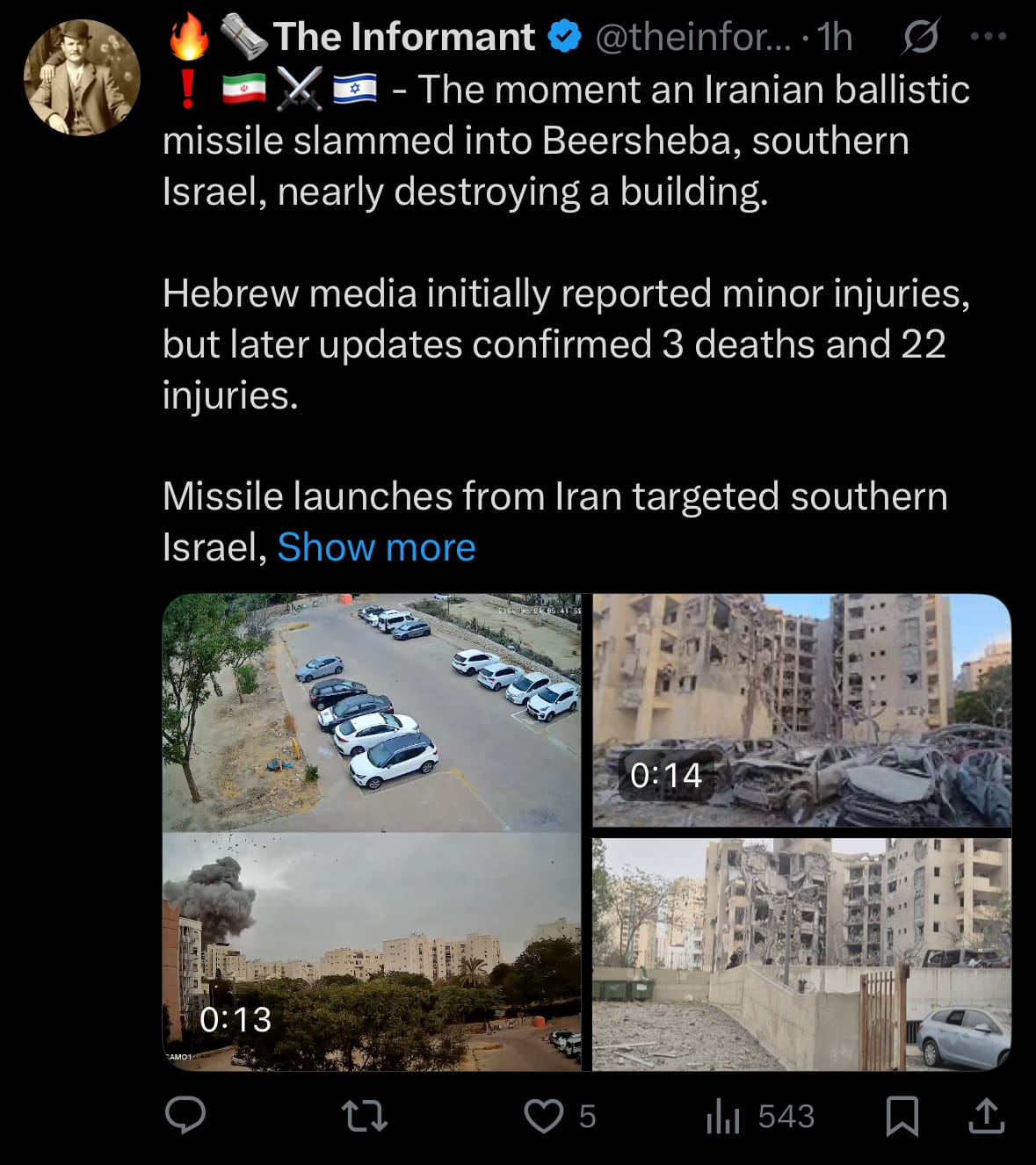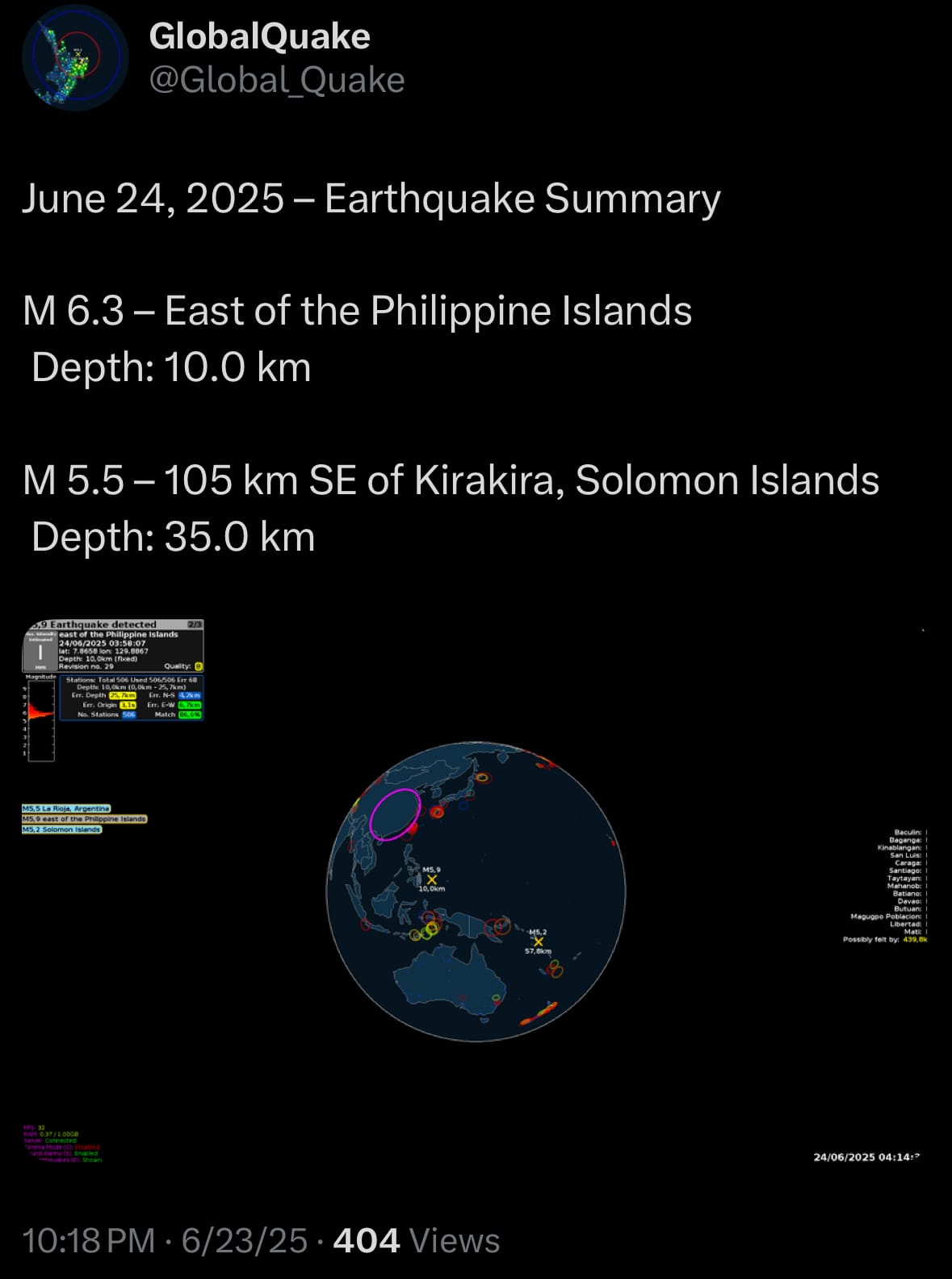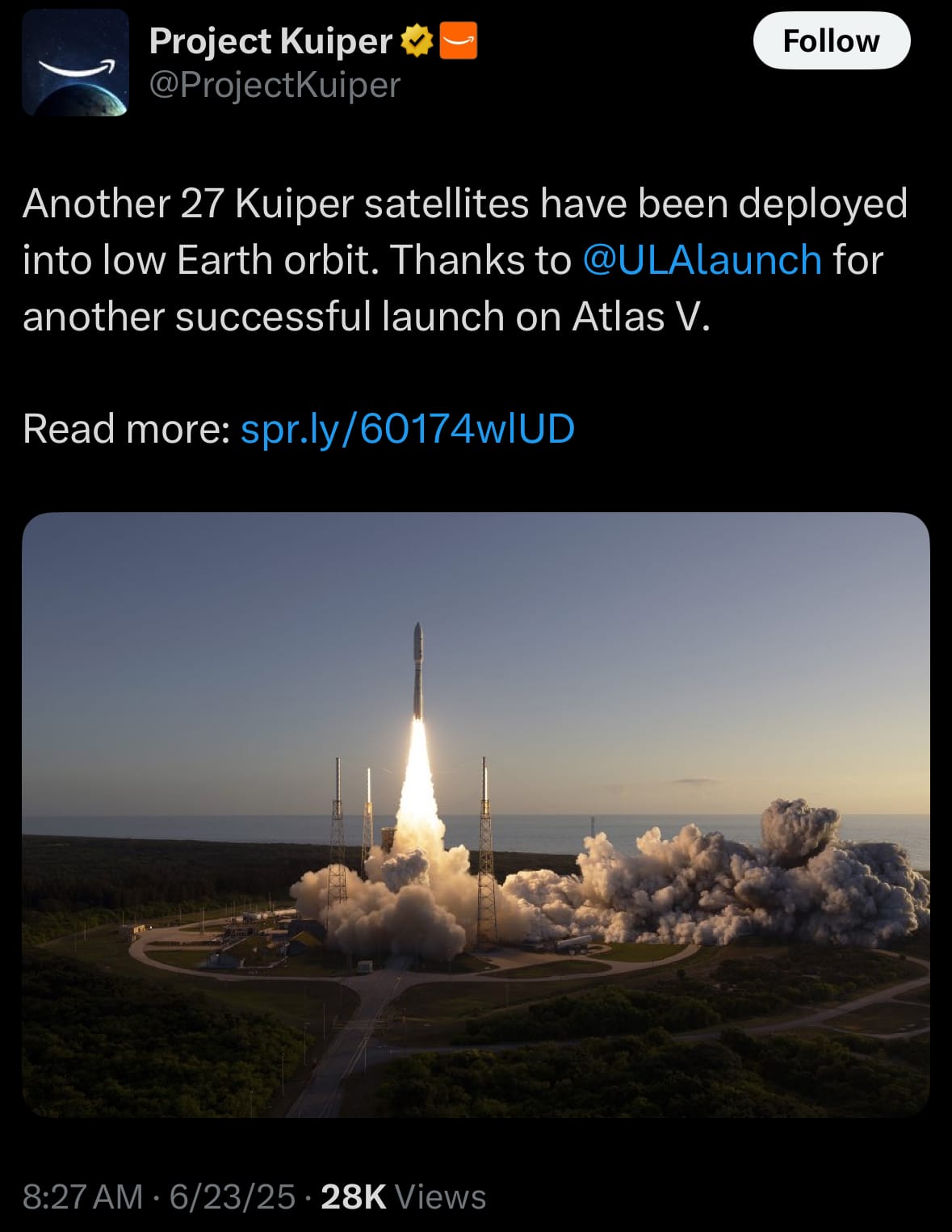Tuesday☕️

Economics & Markets:
- Yesterday’s U.S. stock market:

- Yesterday’s commodity market:

- Yesterday’s crypto market:

Geopolitics & Military Activity:
- As of Today, June 24, 2025 – The Middle East is marked by heightened tensions involving Israel, Iran, and the United States, with a reported ceasefire failing to curb ongoing military actions. On June 23, 2025, U.S. President Donald Trump announced a ceasefire between Israel and Iran, facilitated by Qatari mediation, aimed at ending a 12-day conflict through a phased halt in hostilities starting at midnight EST. However, Iran’s Foreign Minister stated no formal agreement was reached, offering only a conditional pause if Israel stopped attacks by 4 a.m. Tehran time (8:30 p.m. ET, June 23).

- The United States is deeply involved, both militarily and diplomatically. On June 22, 2025, the U.S. conducted airstrikes on Iranian nuclear facilities, prompting Iran’s retaliatory missile attack on the U.S. Al Udeid Air Base in Qatar on June 23. Iran fired 12 to 19 ballistic missiles, but U.S. and Qatari Patriot defenses intercepted most, with one missile striking the base without causing casualties. Despite the ceasefire announcement, hostilities persisted, including Israeli strikes on Hezbollah sites in Lebanon and Iranian military targets. The international community, including the UN Security Council and UN Secretary-General Antonio Guterres, has urged de-escalation, but regional divisions complicate efforts.
Environment & Weather:
- Yesterday, June 23, 2025, Andorra la Vella, Andorra’s capital, experienced significant flooding due to heavy rainfall and a hailstorm. The storm, which began with showers after 3:00 PM and intensified around 4:00 PM, delivered approximately 40 liters of rain per square meter, as reported by local sources. This overwhelmed the city’s drainage systems, leading to flooded streets in areas such as Baixada del Molí and Avinguda Tarragona. Social media posts and videos documented water submerging vehicles and disrupting traffic, with temporary road closures, including at Túnel del Pont Pla, and one reported vehicle rescue using an excavator.

- The flooding affected infrastructure, inundating basements, including facilities of Ràdio Televisió d’Andorra, and disrupting radio and television broadcasts due to an electrical issue at the Pic del Carroi repeater, according to Andorra Telecom. Firefighters conducted around 10 interventions to address the situation, as noted in reports from Diari d’Andorra and 3cat. The event, unexpected after a sunny morning, caused considerable disruption but no casualties were reported. This incident highlights the challenges of managing sudden weather events in Andorra la Vella’s urban environment.

Space:
- Yesterday, June 23, 2025, SpaceX launched the Transporter-14 rideshare mission from Space Launch Complex 4E (SLC-4E) at Vandenberg Space Force Base, California, at 2:18 p.m. PT (5:18 p.m. ET, 2118 UTC). The Falcon 9 rocket carried 70 payloads, including cubesats, microsats, re-entry capsules, and orbital transfer vehicles, into a Sun-synchronous orbit (SSO). Payloads included 45 customer satellites deployed by Exolaunch, The Exploration Company’s Mission Possible, and the Perseverance Flight with over 150 capsules containing cremated remains and DNA samples. The reusable Falcon 9 first-stage booster, B1071, completed its 26th flight and landed on the Of Course I Still Love You droneship in the Pacific Ocean.

- The mission featured a variety of satellites, such as QUICK³, Plan-S/Connecta IoT-10 through 12, MOBIUS-1, UND ROADS 1, and Hyperfield-1B, supporting commercial, scientific, and memorial objectives. Despite earlier weather concerns, conditions allowed for a successful launch. Transporter-14 is part of SpaceX’s smallsat rideshare program, designed to provide affordable access to space for diverse customers.
ULA Launch:
- Yesterday, June 23, 2025, United Launch Alliance (ULA) launched the Project Kuiper KA-02 mission from Space Launch Complex 41 (SLC-41) at Cape Canaveral Space Force Station, Florida, at 6:54 a.m. EDT (1054 UTC). The Atlas V rocket, configured with five solid rocket boosters, carried 27 satellites for Amazon’s Project Kuiper, a planned constellation of 3,236 satellites to provide global broadband internet. An earlier launch attempt on June 21 was postponed due to a technical issue with a booster engine’s purge temperature. The Atlas V successfully deployed the satellites into low-Earth orbit.

- The KA-02 mission supports Amazon’s initiative to deliver high-speed, low-latency internet to underserved communities worldwide. These 27 satellites follow the two launched in October 2023 during the KA-01 mission, marking progress toward the full constellation. ULA is contracted for additional Kuiper launches to expand the network. The mission occurred on the same day as SpaceX’s Transporter-14 launch, reflecting a busy period for U.S. space operations. The Atlas V’s performance ensured accurate satellite deployment, contributing to Amazon’s ongoing efforts to build its broadband network.
Statistic:
- Largest public pharmaceutical companies by market capitalization:
- 🇺🇸 Eli Lilly: $691.83B
- 🇺🇸 Johnson & Johnson: $364.08B
- 🇺🇸 AbbVie: $324.59B
- 🇩🇰 Novo Nordisk: $308.69B
- 🇨🇭 Roche: $255.96B
- 🇨🇭 Novartis: $232.11B
- 🇬🇧 AstraZeneca: $219.01B
- 🇺🇸 Merck: $201.28B
- 🇺🇸 Amgen: $146.49B
- 🇺🇸 Pfizer: $136.61B
- 🇺🇸 Gilead Sciences: $132.09B
- 🇫🇷 Sanofi: $117.32B
- 🇺🇸 Vertex Pharmaceuticals: $113.89B
- 🇺🇸 Bristol-Myers Squibb: $95.48B
- 🇺🇸 CVS Health: $84.51B
- 🇯🇵 Chugai Pharmaceutical: $84.06B
- 🇬🇧 GlaxoSmithKline: $77.95B
- 🇦🇺 CSL: $74.86B
- 🇺🇸 Zoetis: $70.04B
- 🇺🇸 Regeneron Pharmaceuticals: $55.26B
- 🇩🇪 Merck KGaA: $54.73B
- 🇨🇭 Lonza: $49.57B
- 🇨🇳 Jiangsu Hengrui Medicine: $47.76B
- 🇮🇳 Sun Pharmaceutical: $46.05B
- 🇯🇵 Takeda Pharmaceutical: $45.98B
History:
- The development of U.S. missile defense systems began in the mid-20th century, spurred by the escalating nuclear threat posed by the Soviet Union during the Cold War. In the 1950s, the U.S. Army deployed the Nike-Ajax and later Nike-Hercules systems, surface-to-air missiles designed to protect military bases and urban centers from Soviet bomber attacks, with limited capability against early ballistic missiles. By the 1960s, the Safeguard program introduced the Sprint and Spartan missiles, intended to intercept ICBMs targeting the U.S. homeland, particularly to protect Minuteman missile silos. However, the 1972 Anti-Ballistic Missile (ABM) Treaty with the Soviet Union restricted each nation to two (later one) ABM sites, capping homeland defense ambitions to avoid destabilizing the mutually assured destruction (MAD) framework. The Safeguard system, operational briefly in 1975 at Grand Forks, North Dakota, was deactivated due to cost, limited effectiveness, and treaty compliance. In the 1980s, President Ronald Reagan’s Strategic Defense Initiative (SDI), dubbed “Star Wars,” proposed a multi-layered defense incorporating ground-, air-, and space-based systems to neutralize Soviet ICBMs. SDI explored technologies like laser weapons and kinetic interceptors but faced technological and budgetary hurdles, leading to a shift toward more practical theater missile defenses. The 1991 Gulf War highlighted this pivot, as the Patriot missile system, originally an anti-aircraft platform, was adapted to counter Iraqi Scud missiles, achieving mixed success but demonstrating the potential for defending overseas bases and allies against short-range ballistic threats.
- After the Cold War, the U.S. reoriented missile defense to address emerging threats from rogue states like North Korea and Iran, while enhancing protection for the homeland, bases, ships, and allies. The 2002 U.S. withdrawal from the ABM Treaty enabled unrestricted homeland defense development, culminating in the Ground-based Midcourse Defense (GMD) system. GMD, operational since 2004, uses Ground-Based Interceptors (GBIs) at Fort Greely, Alaska, and Vandenberg Space Force Base, California, to target ICBMs in their midcourse phase, outside the atmosphere. With 44 interceptors deployed by 2025, GMD aims to counter attacks from North Korea. For regional and allied defense, the Aegis Ballistic Missile Defense (BMD) system, integrated into Navy destroyers and cruisers, became a cornerstone. Aegis employs the Standard Missile-3 (SM-3) family, including the SM-3 Block IA, IB, and IIA variants, to intercept short- to intermediate-range ballistic missiles during midcourse or ascent phases. Over 50 Aegis-equipped ships, including those stationed in Rota, Spain, and Yokosuka, Japan, provide flexible, sea-based defense for NATO allies, Japan, and South Korea. Ashore, Aegis systems are deployed in Romania and Poland as part of the European Phased Adaptive Approach. The Terminal High Altitude Area Defense (THAAD) system complements Aegis, offering mobile, land-based defense against short- and medium-range missiles in their terminal phase. THAAD batteries, each with six launchers, 48 interceptors, and an AN/TPY-2 radar, are rapidly deployable, as seen in 2013 and 2017 deployments to South Korea to counter North Korean threats, and in 2019 to Israel and the Middle East. THAAD’s high-altitude intercept capability bridges the gap between Patriot’s lower-tier defense and Aegis’s midcourse focus, creating a layered architecture. The U.S. Missile Defense Agency (MDA) integrates these systems via the Command and Control, Battle Management, and Communications (C2BMC) network, enabling real-time data sharing across global deployments. Current efforts focus on countering hypersonic and cruise missiles, with next-generation interceptors and sensor enhancements under development to maintain deterrence against evolving threats.
Image of the day:

Thanks for reading!
Earth is complicated, we make it simple.
Click image to view the Earth Intelligence System:



Support/Suggestions Email:
earthintelligence@earthintel.news




